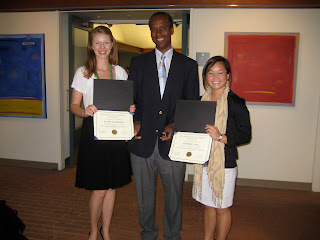Update: Presented at the Conference, had an AMAZING TIME listening to the other students in my panel present their research, and had lots of fun presenting mine as well.
Below: Claire and I with Dean Artis.
Note: This is a rough-ish draft of the introduction I will give tomorrow at the UCSD Undergraduate Research Conference.
Last quarter I conducted research for a colloqium on modern Egyptian history under Professor Hasan Kayali. We had a great deal of freedom to locate our particular interests within the very wide topic of "modern Egyptian history," which refers generally to the period following Napoleon's 1798 invasion of Egypt. As my thoughts were still very much involved with the nationalism in Turkey right now and its effects on the Kurdish minority, I essentially applied many of these curiosities to the Egyptian case study.
The period of my study is from 1881-1923..."ish." This period encompasses three movements which have since been classified as part of the nascent Egyptian nationalist movements - contributions to the idea of a growing, evolving definition of Egyptian. The most basic version of the question is "What kinds of Egyptian nationalisms are these?" This is not a new question! Trying to ascertain the religious, racial or ethnic, territorial characteristics of these movements is a pretty basic goal for most of these studies. However, what I wanted to do was ask these questions via the lens of religious, racial/ethnic, social minority communities in Egypt in this period. The idea was to figure out of it was an Islamic movement via the role of non-Muslim communities -- if non-Muslims participate and are embraced in the rhetoric of the movement - then, well, it's not exclusively Islamic. If non-Arabs are embraced, then its not an Arab movement, etc. I chose Copts, some 500k Christians with long residencies in Egypt; Jews, around 20k (1877 numbers); and finally the Syrian immigrants - some 35k mainly Christian Maronites.
So two sections of the project emerged. First was compiling the information I could find about the three minorities I selected. The "what" question. To what extent do we see Jews, Syrians, and Copts participating in these three nationalist movements? The natural question to follow was "why." If there are (which I say there are) patterns, continuities and evolutions regarding who gets included in the nascent definition of an Egyptian national, then..why? Why is it that Syrians and Jews are increasingly excluded and Copts are increasingly INcluded?
Well, what I hope to show in the the ten minutes is that what Syrians and Jews have in common, what the Copts don't - are levels of socio-cultural integration. Syrians and Jews either fail to or don't care about associating with the Arab Muslims peasants who comprise the vassstttt majority of the population in Egypt at the time. They often do not relate to that indigenous character linguistically, economically, or socially. Finally, they INSTEAD associate with a European identity against which Egyptians were asserting their narratives. The Copts, on the other hand, have a record of residence in Egypt that precedes the Arabs, and their level of social integration is so high that European observers often can't tell the difference between Copts and Muslims.
Thus one could situate my argument with a fairly typical approach to history of this region - I encourage you to think less along the lines of religion, to move away from the preponderance of religion as the sole or dominant element of identification. Instead perceive social integration, in ways a product of religious identity but not limited to, as the determining factor in who gets included or excluded from the idea of "Egyptian."

No comments:
Post a Comment